The AMD FX (Bulldozer) Scheduling Hotfixes Tested
by Anand Lal Shimpi on January 27, 2012 12:47 PM ESTMixed Workloads: Mild Gains
The one thing all of the following benchmarks have in common is they feature more varied CPU utilization. With periods of heavy single and all core utilization, we also see times when these benchmarks use more than one core but fewer than all.
SYSMark has always been a fairly lightly threaded test. While there are definite gains seen when going from 2 to 4 cores, this is hardly a heavily threaded test. The performance impact of the hotfixes is negligible in the overall performance result or across the individual benchmark suites however:
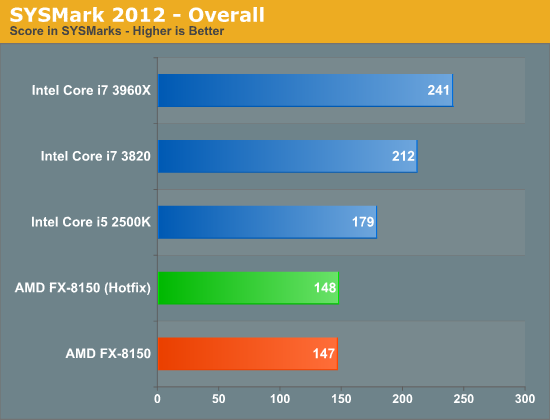
Our Visual Studio 2008 compile test is heavily threaded for the most part, however the beginning of the build process uses a fraction of the total available cores. The hotfixes show a reasonable impact on performance here (~5%):
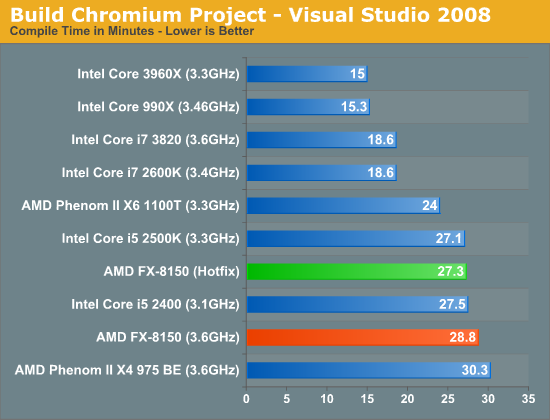
The first pass of our x264 transcode benchmark doesn't use all available cores but it is more than just single threaded:

Performance goes up but only by ~2% here. As expected, the second pass which consumes all cores in the system remains unchanged:
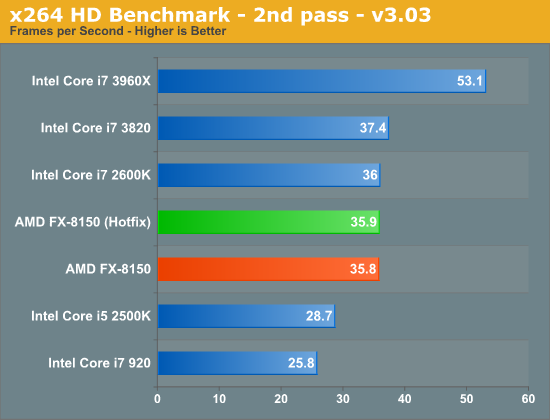
Games are another place we can look for performance improvements as it's rare to see consistent, many-core utilization while playing a modern title on a high-end CPU. Metro 2033 is fairly GPU bound and thus we don't see much of an improvement, although for whatever reason the 51.5 fps ceiling at 19x12 is broken by the hotfixes.

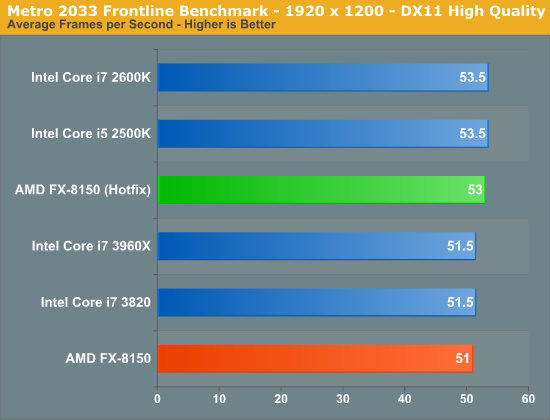
DiRT 3 shows a 5% performance gain from the hotfixes. The improvement isn't enough to really change the standings here, but it's an example of a larger performance gain.
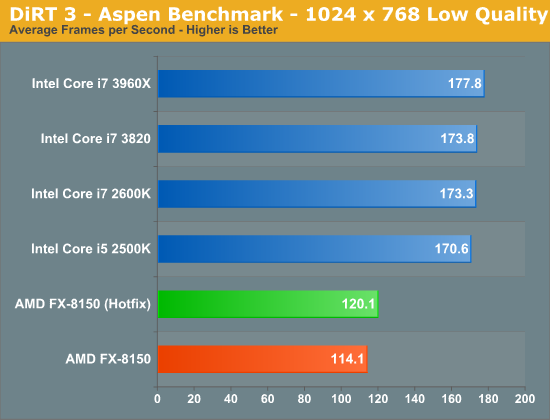
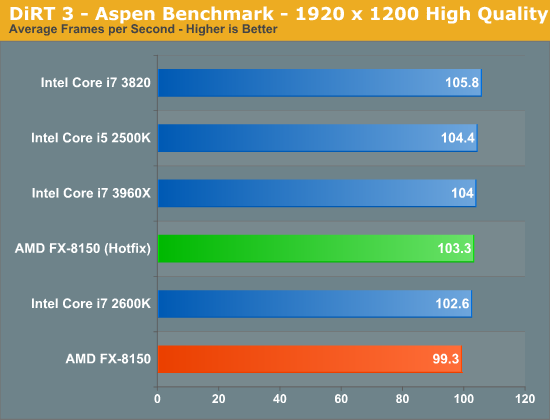
Crysis Warhead mirrors the roughly 5% gain we saw in DiRT 3:
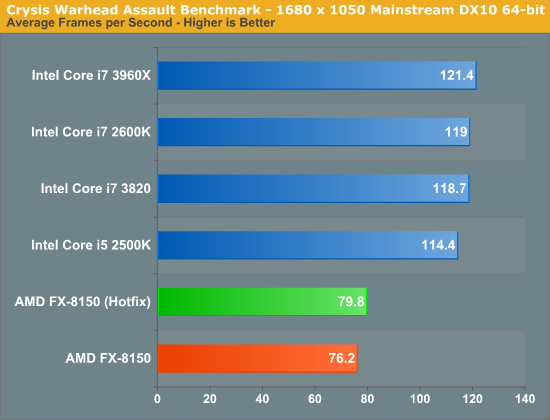
Civilization V's CPU bound no render results show no gains, which is to be expected. But looking at the average frame rate during the simulation we see a 4.9% increase in performance.
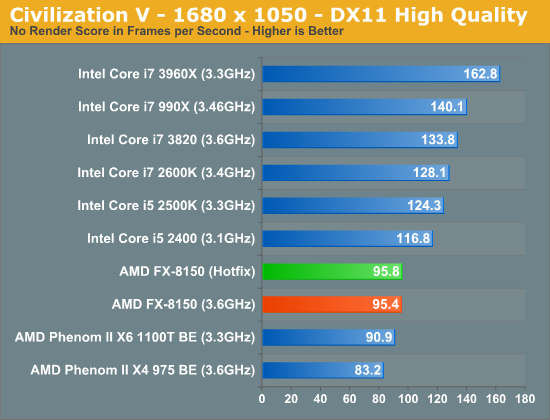
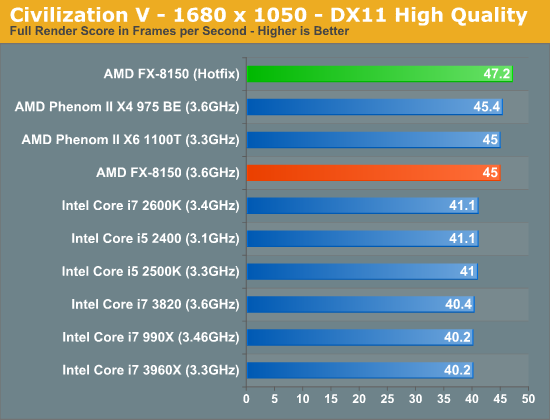










79 Comments
View All Comments
Ammaross - Friday, January 27, 2012 - link
The FX-series chips have been shown to be RAM-dependant as well. Strangling these things with 1600MHz RAM when AMD themselves recommend a minimum of 1866MHz for these chips, but recommend 2166MHz RAM.Anand, perhaps you should show charts that demonstrate whether you're able to repeat these claimed results?
tipoo - Friday, January 27, 2012 - link
I didn't know they recommended 2166. Separate article on Bulldozer memory scaling, perhaps? ;)CUEngineer - Friday, January 27, 2012 - link
I hate how press and AMD try to play off that a bulldozer module is like a dual core or similar to SMT... IT IS NOT.Its simple, there is a single Front end in the module to fetch instructions, this defines the module to be a single "core".... adding integer pipes and making the pipe wider or adding more execution units is simply super scaler architecture they are trying to make wider...
Id like to see their performance analysis because i the ROI is gone when you make your core too wide and thats what they did and they get tremedously underutilized and waste power... GG AMD.
silverblue - Saturday, January 28, 2012 - link
I thought the defining property of a "core" was its integer execution hardware?KonradK - Friday, January 27, 2012 - link
"You can either do two 128-bit operations at once, or one 256-bit operation at once, on a single module. "This means also that two 128bit operations from one thread may be executed at once (as long second does not depend on result of first).
So ultimately benefits of Bulldozer's architecture are no more and no less than benefits than comes from any Hyper-Threading.
Two threads may run on one core at its full speed as long as any of them does not utilize execution units in more than 50% (that is true for not well optimized, and some other specific, programs).
They will not run faster than the same threads running on separate cores.
descendency - Friday, January 27, 2012 - link
The problem here is that the scheduling isn't the problem.It's the single core (per clock) performance. This thing is more expensive than a 2500k and yet has to compete with it.
In all honesty, if you are looking for a gaming PC that is still decent in other apps, I'd recommend a 1050T and spend the savings on a better GPU. With an AM3+ motherboard, you can wait for AMD to fix the hardware.
saneblane - Friday, January 27, 2012 - link
I don't need it, I run i5 2500. It's kind of amazing that people are still confused about whether bulldozer on the desktop failed. If you are one of those people who think that Bulldozer is worth the money, then you deserve to buy it. Denying the truth just makes all of you look stupid. Bulldozer only manage to bulldoze itself, sales figures doesn't matter to me, because I am not AMD nor do I have stock invested in them, so sales figures is irrelevant to most people except AMD, and stock holders. It's because of people like you that kiss AMD's ass for all of the there highend failures, that even to this day Amd doesn't see the need to improve themselves because people would buy whatever they make. What a bunch of fools you all are.Flunk - Saturday, January 28, 2012 - link
I think his point is more that while this does improve bulldozer performance a little bit, it doesn't do anything to make it anywhere near competitive with Intel's offerings. Therefore the product is fairly useless.bji - Saturday, January 28, 2012 - link
As always, people neglect price when they describe product merits. Bulldozer is not a "fairly useless" product because it competes well with Intel CPUs in its price range. No, it does not compete with high end Intel CPUs, but those are not in its price range. AMD has no choice but to price the part so that its value proposition is comparable to Intel parts of the same performance, otherwise the part would not sell. This may make AMD less money but for the consumer, it is a fine CPU in its price range.Ratman6161 - Saturday, January 28, 2012 - link
Just checked NewEgg and an 8150 is $40 more expensive than a 2500K and $30 less than a 2600K. -so if falls right in between on price.Looking at the benchmarks, if gaming is not your primary concern then on a performance basis, the 8150 competes roughly with the 2500K. If gaming is your primary concern then the 2500K is the clear winner on performance.
So best case the 2500K and 8150 are evenly matched and worst case the 8150 gets trounced. So it has no business being priced $40 higher. To me, to be competitive it needs to be the same to lower price than a 2500K. And if you are someone willing to spend $40 more, you might as will just go $70 more for the 2600K.
So I just can't see how anyone can say it compares favorably with the Intel products in its price range.